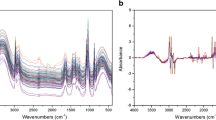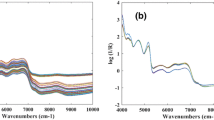Abstract
Fourier transform mid-infrared (Mid-FTIR) spectroscopy in conjunction with multivariate analysis was used to predict the capsaicin content, ascorbic acid, total phenolic compounds, and antioxidant activity of Capsicum annuum L. variety serrano. Two multivariate calibrations, partial least square (PLS), and principal component regression (PCR) were optimized to construct the calibration models. The best models used to quantify the above mentioned compounds were obtained with the PLS algorithm and coefficients of determination (R2) greater than 0.998 as well as a standard error calibration less than 0.098. The results demonstrated that Mid-FTIR spectroscopy in combination with multivariate analysis can be effectively used for to quantify the capsaicin, ascorbic acid, total phenol content, and antioxidant activity of Capsicum annuum var. serrano. Mid-FTIR spectroscopy in combination with multivariate calibration offers rapid, easy sample preparation, is environmentally friendly, and is operationally uncomplicated, demonstrating the significant advantages of the chemometric models compared with conventional methods of analysis.
Similar content being viewed by others
References
Álvarez-Parrilla E, De La Rosa L, Amarowicz R, and Shahidi F (2011) Antioxidant activity of fresh and processed Jalapeño and Serrano peppers. J Agric Food Chem 59, 163–173.
Arnao MB (2000) Some methodological problems in the determination of antioxidant activity using chromogen radicals: a pratical case. Trends in Food Sci Technol 11, 419–421.
Barbero G, Palma M, and Barroso C (2006a) Pressurized Liquid Extraction of Capsaicinoids from Peppers. J Agric Food Chem 54(9), 3231–3236.
Barbero G, Palma M, and Barroso C (2006b) Determination of capsaicinoids in peppers by microwave-assisted extraction-high-performance liquid chromatography with fluorescence detection. Anal Chim Acta 578, 227–233.
Beebe KR, Pell RJ, and Deascholtz MB (1998) Chemometrics: A practical guide. John Wiley & Sons Inc., USA.
Brian P, Rodney B, Kelly G, Titan F, Bonnie T, Alison P et al. (2002) Determination of capsaicinoids in salsa by Liquid Chromatography and Enzyme Immunoassay. J AOAC Intern 85(1), 82–85.
Charles DJ (2013) Introduction. In: Antioxidant properties of spices, herbs, and other sources, pp. 3–8, Springer + Business Media, USA.
Chen D and Wu Z (2009) Study on extraction and purification process of Capsicum red pigment. J Agric Sci 1(2), 94–100.
Cisneros-Pineda O, Torres-Tapia L, Gutiérrez-Pacheco L, Contreras-Martín F, González-Estrada T, and Peraza-Sánchez S (2007) Capsaicinoids quantification in chili peppers cultivated in the state of Yucatan, Mexico. Food Chem 104, 1755–1760.
Conforti F, Statti GA, and Menichini F (2006) Chemical and biological variability of hot pepper fruits (Capsicum annuum var. acuminatum L.) in relation to maturity stage. J Food Chem 102, 1096–1104.
Deepa N, Kaur C, George B, Singh B, and Kapoor H (2007) Antioxidant constituents in some sweet pepper (Capsicum annuum L.) genotypes during maturity. LWT, 40, 121–129.
Díaz J, Pomar F, Bernal A, and Merino F (2004) Peroxidases and the metabolism of capsaicin in Capsicum annuum L. Phytochem Rev, 3, 141–157.
Dion MAM and Saskia M (2008) An overview of analytical methods for determining the geographical origin of food products. Food Chem, 107, 897–911.
Dorantes L, Colmenero R, Hernández H, Mota L, Jaramillo ME, Fernández E et al. (2000) Inhibition of growth of some foodborne pathogenic bacteria by Capsicum annuum extracts. J Food Microbiol, 57, 125–128.
Estrada B, Bernal MA, Díaz J, Pomar F, and Merino F (2000) Fruit development in Capsicum annuum: changes in capsaicin, lignin, free phenolics, and peroxidase patterns. J Agric Food Chem, 48, 6234–6239.
FAOSTAT (2011) Food and Agriculture Organization of the United Nations, USA
Fett D (2003) Capsicum peppers. Cutis, 72, 21–23.
Garcés-Claver A, Gil-Ortega R, Álvarez-Fernández A, and Arnedo-Andrés MA (2007) Inheritance of capsaicin and dihydrocapsaicin, determined by HPLC-ESI/MS, in an intraspecific cross of Capsicum annuum L. J Agric Food Chem, 55, 6951–6957.
Hervert-Hernández D, Sáyago-Ayerdi S, and Goñi I (2010) Bioactive compounds of Four Hot Peppers Varieties (Capsicum annuum L.) Antioxidant capacity, and intestinal bioaccesibility. J Agric Food Chem, 58, 3399–3406.
Howard LR, Talcott ST, Brenes CH, and Villalon B (2000) Changes in phytochemical and antioxidant activity of selected pepper cultivars (Capsicum species) as influenced by maturity. J Agric Food Chem, 48, 1713–1720.
Iñón FA, Garrigues S, and De la Guardia, M (2004) Nutritional parameters of commercially available milk samples by FTIR and Chemometric Techniques. Anal Chimica Acta, 513, 401–412.
Ivanova DG and Singh BR (2003) Nondestructive FTIR monitoring of leaf senescence and elicitin-induced changes in plant leaves. Biopolymers, 72(2), 79–85.
Kähkönen MP, Hopia AI, Vuorela HJ, Rauha JP, Pihlaja K, and Kujala TS (1999) Antioxidant activity of plant extracts containing phenolic compounds. J Agric Food Chem, 47, 3954–3962.
Kawada T, Watanabe T, Katsura K, Takami H, and Iwai K (1985) Formation and metabolism of pungent principle of Capsicum fruits. XV. Microdetermination of capsaicin by high-performance liquid chromatography with electrochemical detection. J Chromatogr, 329 (1), 99–105.
Kozukue N, Han J-S, Kozukue E, Lee S-J, Kim J-A, Lee K-R et al. (2005) Analysis of eight capsaicinoids in peppers and pepper-containing foods by High-Performance Liquid Chromatography and Liquid Chromatography-Mass Spectrometry. J Agric Food Chem, 53(23), 9172–9181.
Lee, K-R, Suzuki T, Kobashi M, Hasegawa K, and Iwai K (1976) Quantitative microanalysis of capsaicin, dihydrocapsaicin, and nordihydrocapsaicin using mass fragmentography. J Chrom, 123, 119–128.
Lee SK and Kader AA (2000) Preharvest and postharvest factors influencing vitamin C content of horticultural crops. Postharvest Biol Technol, 20(3), 207–220.
Marin A, Ferreres F, Tomas-Barberan FA, and Gil MI (2004) Characterization and quantification of antioxidant constituents of sweet pepper (Capsicum annuum L.). J Agric Food Chem, 52, 3861–3869.
Materska M and Perucka I (2005) Antioxidant activity of the main phenolic compounds isolated from hot pepper fruit (Capsicum annuum L.). J Agric Food Chem, 53, 1750–1756.
Medina-Juárez LA, Molina-Quijada D, Del Toro C, González-Aguilar G, and Gámez-Meza N (2012) Antioxidant activity of peppers (Capsicum annuum L.) extracts and characterization of their phenolic constituents. Interciencia 37(8), 588–593.
Meghvansi MK, Siddiqui S, and Khan MH (2010). Naga chilli: a potential source of capsaicinoids with broad-spectrum ethnopharmacological applications. J Ethnopharmacol, 132(1), 1–14.
Meza-Márquez OG, Gallardo-Velázquez T, and Osorio-Revilla G (2010) Application of mid-infrared spectroscopy with multivariate analysis and soft independent modeling of class analogies (SIMCA) for the detection of adulterants in minced beef. Meat Sci, 86, 511–519.
Muñoz DY and Ledesma SJA (2002) In Tablas de valor nutritivo de alimentos, McGraw Hill Interamericana. México.
NOM-F-389-1982. Alimentos. Especias y condimentos. Determinación de capsaicina en Capsicums. Normas mexicanas. Dirección General de Normas. México.
Ornelas-Paz JJ, Martínez-Burrola JM, Ruíz-Cruz S, Santana-Rodríguez V, Ibarra-Junquera V, Olivas GI et al. (2010) Effect of cooking on the capsaicinoids and phenolics contents of Mexican peppers. Food Chem, 119, 1619–1625.
Pino J, González M, Ceballos L, Centurión-Yah A, Trujillo-Aguirre J, Latournerie-Moreno L et al. (2007) Characterization of total capsaicinoids, colour and volatile compounds of Habanero chilli pepper (Capsicum chinense Jack.) cultivars grown in Yucatan. Food Chem, 104, 1682–1686.
Quiñones-Islas N, Meza-Márquez OG, Osorio-Revilla G, and Gallardo-Velazquez T (2013) Detection of adulterants in avocado oil by Mid-FTIR spectroscopy and multivariate analysis. Food Res Inter 51, 148–154.
Ranganna S (1986) In Handbook of analysis and quality control for fruit and vegetable products, (2nd ed). Tata Mc Graw Hill Publishing Company Ltd. India.
Robbins W (2000) Clinical application of capsaicinoids. Clinical J Pain 16(2), 86–89.
Rohman A and Che-Man YB (2011) The use of Fourier transform mid infrared (FT-MIR) spectroscopy for detection and quantification of adulteration in virgin coconut oil. Food Chem 129, 583–588.
Shenk JS and Westerhaus MO (1996) Calibration the ISI way. In Near infrared spectroscopy, Davies AMC and Williams PC (eds.), Chichester, NIR Publications, UK.
Sim KH and Sil HY (2008) Antioxidant activities of red pepper (Capsicum annuum) pericarp and seed extract. J Food Sci Technol 43, 1813–1823.
Sivakesava S and Irudayaraj J (2001) A Rapid Spectroscopic Technique for determining honey adulteration with corn syrup. J Food Sci 66(6), 787–792.
Sun T, Xu Z, Wu CT, Janes M, Prinyawiwatkul W, and No HK (2007) Antioxidants activities of different colored sweet bell peppers (Capsicum annuum L.). J Food Sci, 72(2), S98–S102.
Tewari J and Irudayaraj J (2004) Quantification of saccharides in multiple floral honeys using Fourier Transformed Infrared Microattenuated Total Reflectance Spectroscopy. J Agric Food Chem 52, 3237–3243.
Topuz A and Ozdemir F (2007) Assessment of carotenoids, capsaicinoids and ascorbic acid composition of some selected pepper cultivars (Capsicum annuum L.) grown in Turkey. J Food Comp Anal 20, 596–602.
Velioglu YS, Mazza G, Gao L, and Oomah BD (1998) Antioxidant activity and total phenolics in selected fruits, vegetables and grain products. J Agric Food Chem 46, 4113–4117.
Weaver KM and Awde DB (1986) Rapid high-performance liquid chromatographic method for the determination of very low capsaicin levels. J Chromatog 367, 438–442.
Author information
Authors and Affiliations
Corresponding author
Rights and permissions
About this article
Cite this article
Domínguez-Martínez, I., Meza-Márquez, O.G., Osorio-Revilla, G. et al. Determination of capsaicin, ascorbic acid, total phenolic compounds and antioxidant activity of Capsicum annuum L. var. serrano by mid infrared spectroscopy (Mid-FTIR) and chemometric analysis. J Korean Soc Appl Biol Chem 57, 133–142 (2014). https://doi.org/10.1007/s13765-013-4295-y
Received:
Accepted:
Published:
Issue Date:
DOI: https://doi.org/10.1007/s13765-013-4295-y




